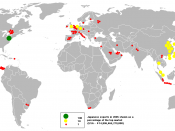As trade intensified leading into the 16th and 17th centuries, in the individual regions of the globe, the trade of silver greatly ascended and became the first product (along with gold) to be traded across all oceans and into all continents and communities. It's production and trade comprised to develop the worlds first global market, which in turn developed a global economy. In this opening of the global market Japan and Spain were the major competitors/developers and China followed by India were the major importers. Because of the prosperous situation in the events after the major silver trade, it can be said with great ease that Japan was the main beneficiary of the trade of the white metal.
Spain was the largest source of silver export during this period. It acted as a middleman and decided to sell its silver resources to places such as China and India instead of stockpile it.
Spain's profit on silver was much greater then Japan's for the simple reason that its mines were richer in the resource. In addition, its mines functioned at lower costs because of their vast supply of mercury, the integral part of silver mining. The downfall of the Spain silver trade was its political inadequacies. The 20 percent tax revenue that was collected off the private miners, and the profits that arose form the sale of the Crown monopoly of mercury were all unwisely spent in war efforts that resulted in no long term benefits for Spain's financial well being. As a result its domestic under-development continued.
While Spain enjoyed a great deal of wealth as a result of its vast silver resources in a short time the greater beneficiary of the silver trade can be seen as the silver trade began to die down. Japan always behind Spain...


